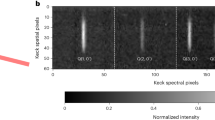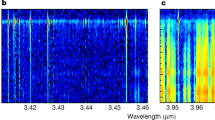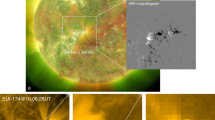Abstract
The majority of planetary aurorae are produced by electrical currents flowing between the ionosphere and the magnetosphere which accelerate energetic charged particles that hit the upper atmosphere. At Saturn, these processes collisionally excite hydrogen, causing ultraviolet emission1,2,3,4,5,6,7,8, and ionize the hydrogen, leading to H3+ infrared emission9,10,11,12,13,14,15. Although the morphology of these aurorae is affected by changes in the solar wind6,11, the source of the currents which produce them is a matter of debate16,17. Recent models predict only weak emission away from the main auroral oval18. Here we report images that show emission both poleward and equatorward of the main oval (separated by a region of low emission). The extensive polar emission is highly variable with time, and disappears when the main oval has a spiral morphology; this suggests that although the polar emission may be associated with minor increases in the dynamic pressure from the solar wind, it is not directly linked to strong magnetospheric compressions. This aurora appears to be unique to Saturn and cannot be explained using our current understanding of Saturn’s magnetosphere. The equatorward arc of emission exists only on the nightside of the planet, and arises from internal magnetospheric processes that are currently unknown.
This is a preview of subscription content, access via your institution
Access options
Subscribe to this journal
Receive 51 print issues and online access
$199.00 per year
only $3.90 per issue
Buy this article
- Purchase on Springer Link
- Instant access to full article PDF
Prices may be subject to local taxes which are calculated during checkout



Similar content being viewed by others
References
Sandel, B. R. et al. Extreme ultraviolet observations from the Voyager 2 encounter with Saturn. Science 215, 548–553 (2005)
Trauger, J. T. et al. Saturn’s hydrogen aurora: Wide field and planetary camera 2 imaging from the Hubble Space Telescope. J. Geophys. Res. 103, 20237–20244 (1998)
Gérard, J.-C. et al. Characteristics of Saturn’s FUV aurora observed with the Space Telescope Imaging Spectrograph. J. Geophys. Res. 109, A09207 (2004)
Clarke, J. T. et al. Morphological differences between Saturn’s ultraviolet aurorae and those of Earth and Jupiter. Nature 433, 717–719 (2005)
Grodent, D., Gérard, J.-C., Cowley, S. W. H., Bunce, E. J. & Clarke, J. T. Variable morphology of Saturn’s southern ultraviolet aurora. J. Geophys. Res. 110, A07215 (2005)
Bunce, E. J. et al. Cassini observations of the interplanetary medium upstream of Saturn and their relation to Hubble Space Telescope auroral data. Adv. Space Res. 38, 806–814 (2006)
Badman, S. V., Cowley, S. W. H., Gérard, J.-C. & Grodent, D. A statistical analysis of the location and width of Saturn’s southern auroras. Ann. Geophys. 24, 3533–3545 (2006)
Bunce, E. J. et al. Origins of Saturn’s aurora: Simultaneous observations by Cassini and the Hubble Space Telescope. J. Geophys. Res. 113, A09209 (2008)
Stallard, T. et al. The H3 + latitudinal profile of Saturn. Astrophys. J. 521, L149–L152 (1999)
Stallard, T., Miller, S., Trafton, L. M., Geballe, T. R. & Joseph, R. D. Ion winds in Saturn’s southern auroral/polar region. Icarus 167, 204–211 (2004)
Stallard, T. et al. Saturn’s auroral/polar H3 + infrared emission I: General morphology and ion velocity structure. Icarus 189, 1–13 (2007)
Stallard, T. et al. Saturn’s auroral/polar H3 + infrared emission II: A comparison with plasma flow models. Icarus 191, 678–690 (2007)
Melin, H., Miller, S., Stallard, T., Trafton, L. M. & Geballe, T. R. Variability in the H3 + emission of Saturn: Consequences for ionisation rates and temperature. Icarus 186, 234–241 (2007)
Stallard, T. et al. Jovian-like aurorae on Saturn. Nature 453, 1083–1085 (2008)
Stallard, T., Lystrup, M. & Miller, S. Emission-line imaging of Saturn’s H3 + aurora. Astrophys. J. 675, L117–L120 (2008)
Cowley, S. W. H., Bunce, E. J. & O’Rourke, J. M. A simple quantitative model of plasma flows and currents in Saturn’s polar ionosphere. J. Geophys. Res. 109, A05212 (2004)
Sittler, E. C., Blanc, M. F. & Richardson, J. D. Proposed model for Saturn’s auroral response to the solar wind: Centrifugal instability model. J. Geophys. Res. 111, A06208 (2006)
Cowley, S. W. H. & Bunce, E. J. Corotation-driven magnetosphere-ionosphere coupling currents in Saturn’s magnetosphere and their relation to the auroras. Ann. Geophys. 21, 1691–1707 (2003)
Pryor, W. R. et al. Auroral movies and spectroscopy from Cassini UVIS. Abstract no. P31A–0187 (Fall Meeting, American Geophysical Union, 2007)
Drossart, P. et al. Mapping the H3 + aurora on Saturn from Cassini/VIMS observations. Bull. Am. Astron. Soc. 37, 657 (2005)
Cowley, S. W. H. et al. Reconnection in a rotation-dominated magnetosphere and its relation to Saturn’s auroral dynamics. J. Geophys. Res. 110, A02201 (2005)
Grodent, D. et al. Jupiter’s polar auroral emissions. J. Geophys. Res. 108, 1366–1374 (2003)
Stallard, T., Miller, S., Millward, G. & Joseph, R. D. On the dynamics of the Jovian ionosphere and thermosphere II: The measurement of H3 + vibrational temperature, column density, and total emission. Icarus 156, 498–514 (2002)
Millward, G., Miller, S., Stallard, T., Aylward, A. & Achilleos, N. On the dynamics of the Jovian ionosphere and thermosphere III: The modelling of auroral conductivity. Icarus 160, 95–104 (2002)
Baker, D. N., Higbie, P. R., Hones, E. W. & Belian, R. D. High resolution energetic particle measurements at 6.6RE 3. Low energy electron anisotropies and short-term substorm predictions. J. Geophys. Res. 83, 4863–4868 (1978)
Hill, T. W. The Jovian auroral oval. J. Geophys. Res. 106, 8101–8108 (2001)
Acknowledgements
This work was supported by a Research Councils UK Fellowship (T.S.) and by the UK Science and Technology Facilities Council (N.A., S.V.B., D.L.T., C.S.A., E.J.B., M.K.D.). The European authors are part of the Europlanet European Planetology Network, supported by the European Union’s Sixth Framework Programme.
Author Contributions T.S. analysed the data and wrote the paper; S.M., M.L. and N.A. aided data analysis; E.J.B., C.S.A., M.K.D., S.W.H.C., S.V.B. and D.L.T. provided discussion as members of the UK MAG-VIMS collaboration team; and R.H.B., K.H.B., B.J.B., R.N.C., C.S., P.D.N. and P.D. provided the reduced data and discussion as members of the Cassini VIMS team. All authors commented on the manuscript.
Author information
Authors and Affiliations
Corresponding author
Supplementary information
Supplementary Information
This file contains a Supplementary Discussion, Supplementary Data and Supplementary References. (PDF 68 kb)
Rights and permissions
About this article
Cite this article
Stallard, T., Miller, S., Lystrup, M. et al. Complex structure within Saturn’s infrared aurora. Nature 456, 214–217 (2008). https://doi.org/10.1038/nature07440
Received:
Accepted:
Issue Date:
DOI: https://doi.org/10.1038/nature07440
This article is cited by
-
Detection of the infrared aurora at Uranus with Keck-NIRSPEC
Nature Astronomy (2023)
-
Auroral Processes at the Giant Planets: Energy Deposition, Emission Mechanisms, Morphology and Spectra
Space Science Reviews (2015)
-
Particle Acceleration in the Magnetotail and Aurora
Space Science Reviews (2012)
Comments
By submitting a comment you agree to abide by our Terms and Community Guidelines. If you find something abusive or that does not comply with our terms or guidelines please flag it as inappropriate.



